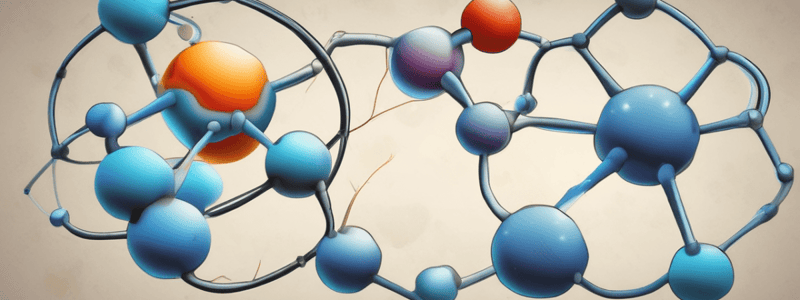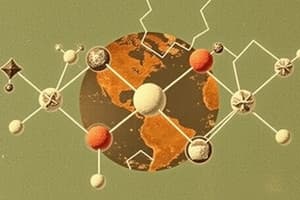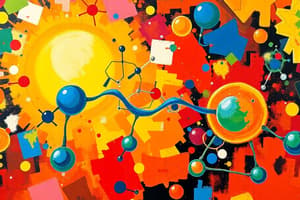Podcast
Questions and Answers
What is the main characteristic that defines an ionic bond?
What is the main characteristic that defines an ionic bond?
- Electrons are not shared, but transferred (correct)
- Electrons are shared between atoms
- Molecules are formed by sharing electrons
- Atoms lose or gain electrons to form compounds
Which of the following is a characteristic of water?
Which of the following is a characteristic of water?
- It is a large molecule that forms weak hydrogen bonds
- It is a nonpolar molecule that forms extensive covalent bonds
- It is a small molecule that forms extensive covalent bonds (correct)
- It is a polar molecule that forms weak covalent bonds
What is the arrangement of electrons in a polar covalent bond?
What is the arrangement of electrons in a polar covalent bond?
- Electrons are not shared, but are localized on one atom
- Electrons are shared equally between atoms
- Electrons are transferred from one atom to another
- Electrons are shared unequally between atoms (correct)
What is the term for an atom or molecule that carries a charge?
What is the term for an atom or molecule that carries a charge?
Which of the following is NOT a characteristic of water?
Which of the following is NOT a characteristic of water?
What is the term for the strength with which atoms pull electrons towards themselves?
What is the term for the strength with which atoms pull electrons towards themselves?
What is the significance of the electronegativity of oxygen?
What is the significance of the electronegativity of oxygen?
What is the significance of nonpolar covalent bonds in biological systems?
What is the significance of nonpolar covalent bonds in biological systems?
What is a characteristic of water that makes it an excellent solvent?
What is a characteristic of water that makes it an excellent solvent?
What type of molecules stay in solution due to their interactions with water's partial charges?
What type of molecules stay in solution due to their interactions with water's partial charges?
What is the reason why hydrophobic molecules do not dissolve in water?
What is the reason why hydrophobic molecules do not dissolve in water?
What is the term for the attraction between like molecules?
What is the term for the attraction between like molecules?
What is the result of water's high thermal capacity?
What is the result of water's high thermal capacity?
What type of molecules interact with each other through van der Waals interactions?
What type of molecules interact with each other through van der Waals interactions?
What is the term for the attraction between unlike molecules?
What is the term for the attraction between unlike molecules?
Why does solid water (ice) float on top of liquid water?
Why does solid water (ice) float on top of liquid water?
What happens when an acid is added to a solution?
What happens when an acid is added to a solution?
What is the pH of a neutral solution?
What is the pH of a neutral solution?
What is the function of buffers in organisms?
What is the function of buffers in organisms?
What is unique about carbon atoms?
What is unique about carbon atoms?
What is the result of adding a base to a solution?
What is the result of adding a base to a solution?
What is the significance of the pH scale?
What is the significance of the pH scale?
What is the characteristic of organic compounds?
What is the characteristic of organic compounds?
What is the normal pH of the solution inside living cells?
What is the normal pH of the solution inside living cells?
What is the primary reason why atoms form covalent bonds?
What is the primary reason why atoms form covalent bonds?
Which of the following elements has the highest electronegativity among the biologically abundant elements?
Which of the following elements has the highest electronegativity among the biologically abundant elements?
What is the result of the transfer of an electron from one atom to another in an ionic bond?
What is the result of the transfer of an electron from one atom to another in an ionic bond?
What is the significance of water's ability to form extensive hydrogen bonds with itself and with polar groups on nearby molecules?
What is the significance of water's ability to form extensive hydrogen bonds with itself and with polar groups on nearby molecules?
What is the percentage of a cell that is composed of water?
What is the percentage of a cell that is composed of water?
What is the main reason why ions and polar molecules stay in solution?
What is the main reason why ions and polar molecules stay in solution?
Which type of molecules have a high energy cost of breaking water's hydrogen bonds?
Which type of molecules have a high energy cost of breaking water's hydrogen bonds?
What is the main reason why water has a high specific heat?
What is the main reason why water has a high specific heat?
Which functional group is found in organic compounds and has sites that link molecules into more-complex compounds?
Which functional group is found in organic compounds and has sites that link molecules into more-complex compounds?
What is the result of water's high heat of vaporization?
What is the result of water's high heat of vaporization?
What type of molecules are typically found in organisms, except for water?
What type of molecules are typically found in organisms, except for water?
What is the reason why ice floats on top of liquid water?
What is the reason why ice floats on top of liquid water?
What is the function of the phosphate group in organic compounds?
What is the function of the phosphate group in organic compounds?
What is the primary reason why atoms form ionic bonds?
What is the primary reason why atoms form ionic bonds?
Which of the following elements has the highest electronegativity among the biologically abundant elements?
Which of the following elements has the highest electronegativity among the biologically abundant elements?
What is the result of the unequal sharing of electrons in a covalent bond?
What is the result of the unequal sharing of electrons in a covalent bond?
What is the significance of water's ability to form extensive hydrogen bonds with itself and with polar groups on nearby molecules?
What is the significance of water's ability to form extensive hydrogen bonds with itself and with polar groups on nearby molecules?
What is the percentage of a cell that is composed of water?
What is the percentage of a cell that is composed of water?
What is the primary reason why water expands as it freezes?
What is the primary reason why water expands as it freezes?
Which of the following is NOT a characteristic of hydrophobic molecules?
Which of the following is NOT a characteristic of hydrophobic molecules?
What is the primary reason why water has a high specific heat?
What is the primary reason why water has a high specific heat?
What is the function of the hydroxyl group in organic compounds?
What is the function of the hydroxyl group in organic compounds?
What is the primary reason why water has a high heat of vaporization?
What is the primary reason why water has a high heat of vaporization?
What is the primary function of the carbonyl group in organic compounds?
What is the primary function of the carbonyl group in organic compounds?
What is the primary reason why hydrophilic molecules dissolve in water?
What is the primary reason why hydrophilic molecules dissolve in water?
What is the primary reason why water is an excellent solvent?
What is the primary reason why water is an excellent solvent?
Flashcards are hidden until you start studying
Study Notes
Nonpolar and Polar Covalent Bonds
- Electrons in a covalent bond are not always shared equally between atoms
- Electronegativity is the strength with which atoms pull electrons toward themselves
- Electronegativity varies among elements, with oxygen (O) > nitrogen (N) > sulfur (S), carbon (C), hydrogen (H), and phosphorus (P)
Ionic Bonding and Electron-Sharing Continuum
- In an ionic bond, an electron is completely transferred from one atom to another, resulting in the formation of ions
- Cations are formed when an atom loses an electron and becomes positively charged
- Anions are formed when an atom gains an electron and becomes negatively charged
Properties of Water
- Water is essential for life, making up 75% of a cell's composition
- Water is an excellent solvent due to its ability to form extensive hydrogen bonds with itself and with polar groups on nearby molecules
- Water exhibits cohesive and adhesive properties, and its solid form (ice) is less dense than its liquid form
- Water has a high thermal capacity, which is important for life's chemistry
Water as a Solvent
- Hydrogen bonds between water molecules and polar solutes allow ionic and polar molecules to dissolve in water
- Hydrophobic (nonpolar) molecules do not dissolve in water, but interact with each other through hydrophobic interactions
- van der Waals interactions increase the stability of clustered hydrophobic molecules
Cohesion, Adhesion, and Surface Tension
- Cohesion is the attraction between like molecules, while adhesion is the attraction between unlike molecules
- Water is cohesive due to hydrogen bonds, and adheres to surfaces with polar or charged components
Acid-Base Chemical Reactions
- Acids are substances that give up protons during chemical reactions, increasing the hydronium ion concentration (H3O+)
- Bases are substances that acquire protons during chemical reactions, decreasing the hydronium ion concentration
- pH is a logarithmic notation used to express the concentration of protons in a solution
- A pH of less than 7 indicates an acidic solution, while a pH greater than 7 indicates a basic solution
Carbon-Based Life
- Carbon is the basis of almost all molecules found in organisms, except for water
- Carbon forms four covalent bonds due to its four valence electrons
- Organic compounds contain carbon bonded to other elements, resulting in a limitless array of molecular shapes
Covalent Bonds and Electronegativity
- Atoms become more stable by forming covalent bonds, where electrons are shared between atoms.
- Electrons in covalent bonds are not always shared equally, and atoms can pull shared electrons towards their nuclei with varying strengths, known as electronegativity.
- Electronegativity is the strength with which atoms pull electrons towards themselves, and for biologically abundant elements, oxygen has the highest electronegativity, followed by nitrogen, sulfur, carbon, hydrogen, and phosphorus.
Ions and Ionic Bonds
- In an ionic bond, electrons are completely transferred from one atom to another, giving each atom a full valence shell.
- Ions are atoms or molecules that carry a charge, and can be either cations (positively charged) or anions (negatively charged).
Properties of Water
- Water is a vital component of cells, making up 75% of cell content.
- Water forms extensive hydrogen bonds with itself and with polar groups on nearby molecules, leading to several properties essential for life's chemistry.
- Water is an excellent solvent due to its high cohesion and adhesion properties.
- Water has a high thermal capacity, with a high specific heat and heat of vaporization.
- Hydrogen bonds between water molecules and polar solutes enable the dissolution of charged or polar molecules.
Hydrophilic and Hydrophobic Molecules
- Hydrophilic molecules, including ions and polar molecules, interact with water's partial charges, allowing them to stay in solution.
- Hydrophobic molecules, which are uncharged and nonpolar, do not dissolve in water and interact with each other through hydrophobic interactions.
- Van der Waals interactions increase the stability of clustered hydrophobic molecules.
Cohesion and Adhesion
- Cohesion is the attraction between like molecules, while adhesion is the attraction between unlike molecules.
- Water is cohesive due to its hydrogen bonds, and adheres to surfaces with polar or charged components.
- Unlike most substances, water expands as it freezes, forming a less dense solid than its liquid state.
Carbon and Organic Compounds
- Carbon is a crucial atom in organic compounds, forming four covalent bonds due to its four valence electrons.
- Organic compounds have a limitless array of molecular shapes, with different combinations of single and double bonds.
- Six functional groups are found in organic compounds: amino, carboxyl, carbonyl, hydroxyl, phosphate, and sulfhydryl groups.
- Each of these functional groups has specific properties, such as attracting or dropping protons, linking molecules, or being polar and hydrophilic.
Atomic Bonding and Compounds
- Atoms become more stable by forming covalent bonds.
- Electrons in covalent bonds are not always shared equally.
- Compounds are molecules in which atoms of different elements are bonded together.
Electronegativity
- Electronegativity is the strength with which atoms pull electrons toward themselves.
- For biologically abundant elements, the order of electronegativity is: O > N > S > C > H > P.
Ionic Bonds
- Unlike in a covalent bond, electron is completely transferred from one atom to another in an ionic bond.
- This transfer gives each atom a full valence shell.
- Ions are atoms or molecules that carry a charge.
- Cations are atoms that lose an electron and become positively charged.
- Anions are atoms that gain an electron and become negatively charged.
Properties of Water
- Water is a critical component of life, making up 75% of a cell.
- Water is an excellent solvent due to its ability to form extensive hydrogen bonds with itself and with polar groups on nearby molecules.
- Water has cohesive and adhesive properties, allowing it to stick to itself and other surfaces.
- Ice is less dense than liquid water, which makes it float.
- Water has a high thermal capacity, with a high specific heat and heat of vaporization.
- Hydrogen bonds can form between water molecules and polar solutes, allowing them to dissolve in water.
Hydrophilic and Hydrophobic Molecules
- Hydrophilic molecules are ions and polar molecules that stay in solution due to their interactions with water's partial charges.
- Hydrophobic molecules are uncharged and nonpolar compounds that do not dissolve in water.
- Hydrophobic molecules interact with each other through hydrophobic interactions, which increase the stability of clustered hydrophobic molecules.
- Van der Waals interactions also contribute to the stability of clustered hydrophobic molecules.
Cohesion and Adhesion
- Cohesion is the attraction between like molecules, while adhesion is the attraction between unlike molecules.
- Water is cohesive due to hydrogen bonds, which allows it to stick together.
- Water also adheres to surfaces with polar or charged components.
Carbon and Organic Compounds
- Carbon is a critical element in organisms, forming four covalent bonds due to its four valence electrons.
- Organic compounds are molecules that contain carbon bonded to other elements.
- These compounds can form a limitless array of molecular shapes with different combinations of single and double bonds.
- Six functional groups found in organic compounds are:
- Amino groups, which attract protons and act as bases.
- Carboxyl groups, which drop protons and act as acids.
- Carbonyl groups, which have sites that link molecules into more complex compounds.
- Hydroxyl groups, which are polar and hydrophilic.
- Phosphate groups, which have two negative charges.
- Sulfhydryl groups, which link together via disulfide bonds.
Studying That Suits You
Use AI to generate personalized quizzes and flashcards to suit your learning preferences.




